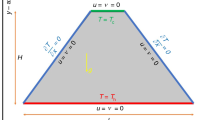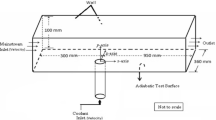Abstract
Numerical simulation methods of aerodynamic heating were compared by considering the influence of numerical schemes and turbulence models, and attempting to investigate the applicability of numerical simulation methods on predicting heat flux in engineering applications. For some typical cases provided with detailed experimental data, four spatial schemes and four turbulence models were adopted to calculate surface heat flux. By analyzing and comparing, some influencing regularities of numerical schemes and turbulence models on calculating heat flux had been acquired. It is clear that AUSM+-up scheme with rapid compressibility-modified high Reynolds number k-ω model should be appropriate for calculating heat flux. The numerical methods selected as preference above were applied to calculate the heat flux of a 3-D complex geometry in high speed turbulent flows. The results indicated that numerical simulation can capture the complex flow phenomena and reveal the mechanism of aerodynamic heating. Especially, the numerical result of the heat flux at the stagnation point of the wedge was well in agreement with the prediction of Kemp-Riddel formula, and the surface heat flux distribution was consistent with experiment results, which implied that numerical simulation can be introduced to predict heat flux in engineering applications.
Similar content being viewed by others
References
Dinesh, K.P., Michael, J.W., Joseph, G.M., et al.: X-33 aerothermal design environment predictions: verification and validation. AIAA Paper 2000-2686 (2000)
Dean, A.K., Michael, J.W., Dinesh, K.P., et al.: X-33 aerothermal design environment predictions: review of acreage and local computations. AIAA Paper 2000-2687 (2000)
Charles, E.C., Aaron, H.A., Jeffrey, A.W., et al.: Aeroheating predictions for the X-43 cowl-closed configuration at Mach 7 and 10. AIAA Paper 2002-0218 (2002)
Zhang, H.J., Ma, H.Y., Tong, B.G.: Turbulence modeling validation in hypersonic complex flows. Acta Aerodynamica Sinica 19(2), 201–216 (2001)
Li, J.Z.: Research on scheme effect and grid effect of computational fluid dynamics in aerothermal. [Master Thesis]. Beihang University, Beijing (2004)
Miller, C.G.: Experimental and predicted heating distributions for biconics at incidence in air at Mach 10. NASA-TP-2334 (1984)
Kordulla, W., Periaux, J.: Attempt to evaluate the computations for test case 6.1: cold hypersonic flow past ellipsoidal shapes. In: Hypersonic Flows for Reentry Problems, Vol. I & II. Springer-Verlag, Antibes, France, 689–712 (1991)
Settles, G.S., Dodson, L.J.: Hypersonic shock/boundary-layer interaction database. NASA-CR-177577 (1991)
Kang, H.L.: Numerical simulation study on aerodynamic heating by hypersonic turbulent flows. [Ph.D. Thesis]. Beihang University, Beijing (2007)
Vuong, S.T., Coakley, T.J.: Modeling of turbulence for hypersonic flows with and without separation. AIAA Paper 87-0286 (1987)
Fay, J.A., Riddell, F.R.: Theory of stagnation point heat transfer in dissociated air. J. Aero. Sci. 25(2), 86–97 (1958)
Author information
Authors and Affiliations
Corresponding author
Rights and permissions
About this article
Cite this article
Luo, JL., Kang, HL., Li, J. et al. Comparisons and applications of numerical simulation methods for predicting aerodynamic heating around complex configurations. Acta Mech Sin 27, 339–345 (2011). https://doi.org/10.1007/s10409-011-0458-4
Received:
Revised:
Accepted:
Published:
Issue Date:
DOI: https://doi.org/10.1007/s10409-011-0458-4




